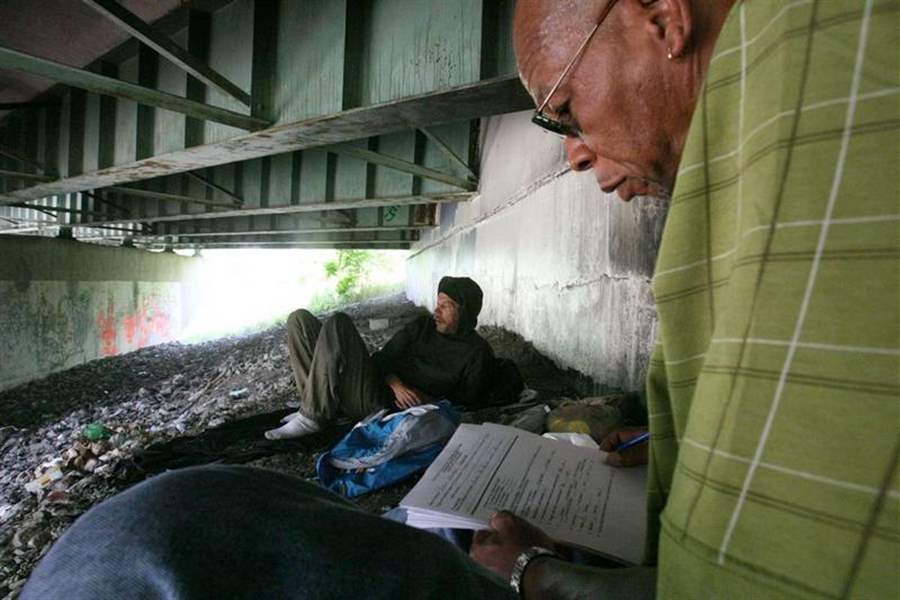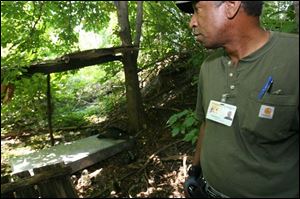
Toledo's homeless population gets tallied
7/30/2008
Derick Brown, a homeless National Guard veteran, reclines by his belongings under an overpass near Emerald Avenue in South Toledo as he answers questions from John Whitlow, an outreach worker with Neighborhood Properties Inc. who is part of a team attempting to count the homeless population in Toledo.

Derick Brown, a homeless National Guard veteran, reclines by his belongings under an overpass near Emerald Avenue in South Toledo as he answers questions from John Whitlow, an outreach worker with Neighborhood Properties Inc. who is part of a team attempting to count the homeless population in Toledo.
From the banks of the Maumee River to outside the former Southwyck Shopping Center, from libraries to parked cars, bus stations, and soup kitchens, homeless advocates scoured the city yesterday in an effort to count the number of people in Toledo without shelter.
The 24-hour count was conducted yesterday by the Toledo Area Alliance to End Homelessness, the Toledo Lucas County Homelessness Board, and dozens of volunteers.
It will take several days before the total number of people found is available, said Debbie Conklin, director of the homelessness board. She said she expected to find 700 to 900 individuals.
One man tallied in the search was Derick Brown, 58, sleeping under an overpass near Emerald Avenue in South Toledo.
Dressed in sweat pants, he had cigarettes, a few bottles of water, and a small plastic bag of pos-sessions. He is a National Guard veteran and has been homeless for six years, he said.
John Whitlow, an outreach technician with Neighborhood Properties Inc., a housing agency, couldn't convince Mr. Brown to go to a shelter, but gave him a jacket, socks, food, a hygiene kit, and a canteen to fill with water.
"It's sad," Whitlow said. "My goal was to get him in this vehicle and take him to a shelter."

Fred Glover, who is on a team attempting to get a summer count of Toledo s homeless population, looks over a wooded area by the Maumee River that appears to be inhabited.
Yesterday's count was to find people just like Mr. Brown, said Paula Lewis, chairman of the Toledo Area Alliance to End Homelessness. "This is to focus on people who are not in the system, the unsheltered, that we would miss," she said.
To receive funding, agencies that work with the homeless are required to submit a point-in- time count to the U.S. Department of Housing and Urban Development, Ms. Lewis said. HUD requires the count to be done in January, and for the first time, local homeless advocates decided to do a count in the summer too, in hopes of finding more people.
"There are more homeless in the community that we can be accessible to in the summer," she said.
A count in January, 2007, found 745 homeless people in Lucas County, with 200 of those classified as "chronically" homeless, according to HUD data. Figures from January of this year were not immediately available.
Nationally, nearly 1.6 million people were homeless and found shelter between Oct. 1, 2006, and Sept. 30, 2007, according to a HUD report released yesterday.
However, the National Coalition for the Homeless cautions that the number of homeless individuals is difficult to count. Homelessness is often temporary, and counts often only include people on the streets or in shelters, not those living with friends or relatives, who aren't defined by HUD as being homeless, and aren't counted by HUD.
Factors leading to homelessness, according to the coalition, include poverty, lack of affordable housing, domestic violence, mental illness, and drug and alcohol addiction.
Ms. Conklin said stereotypes paint the homeless as alcoholics, addicts, or mentally ill, but the reality is much more complex.
"We have significant numbers of homeless families," she said. "We have significant numbers of youth who are leaving foster care. We are seeing people who are leaving foreclosed properties."
Longtime homeless advocate Ken Leslie, who spoke to a number of people yesterday along the river, at libraries, and in shelters, said, "The joy for me came from being able to connect with people, and letting them know that they matter."
Contact Kate Giammarise at:
kgiammarise@theblade.com
or 419-724-6133.